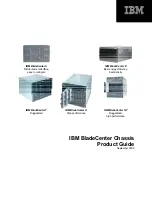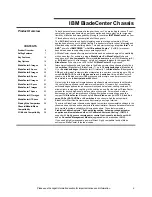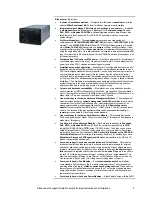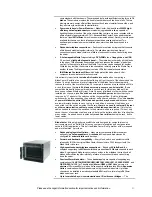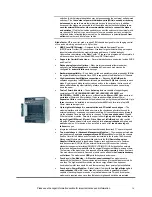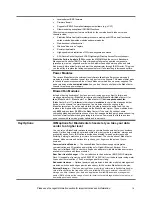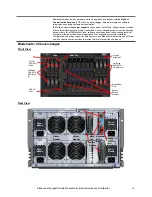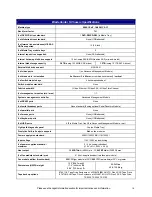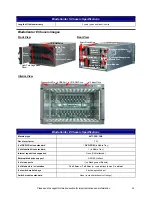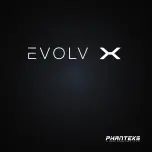
Selling Features
Price/Performance
•
The
extremely high degree of integration
in the various BladeCenter chassis reduces
the need for server components, replacing numerous fans, KVM and Ethernet cables,
power supplies, external switches and other components with fewer
shared
hot-
swap/redundant components in the BladeCenter chassis themselves. This integration also
can greatly
reduce
the amount of
power consumed
and
heat produced
, relative to an
equivalent number of 1U servers—or competitive bade systems. This can significantly
reduce a data center power bill. The
reduced datacenter footprint
can also save on
infrastructure cost.
•
BladeCenter Virtual Fabric
delivers a flexible, open, connected infrastructure to help
optimize application performance. BladeCenter supports many different fabrics, including
Ethernet, Fibre Channel, InfiniBand, iSCSI, and a new SAS fabric, providing an easy
transition to diskless, stateless servers. This helps centralize storage, offering boot
capability, which can dramatically reduce the likelihood of a disk outage. Dual SATA-
attached solid state drives can greatly improve drive availability.
•
Blade servers communicate directly to switch modules
inside the BladeCenter
Virtual Fabric via redundant Ethernet links to help increase the speed and efficiency
of data transfers across blade servers and networks. In addition, the midplanes used
in all chassis provide
high-speed blade-to-blade
(via high-availability firmware)
and
module-to-module communications
internally as well as externally. The midplane used
in the BladeCenter H and HT provides
four 10Gb
data channels to each blade, and
supports
4X InfiniBand
(HT only) and
10Gb Ethernet
high-speed switch modules.
•
IBM Cool Blue technology’s web-based
Power Configurator
accurately predicts the
power and cooling required for specific configurations, thereby enabling realistic planning
of the correct power and cooling infrastructure. The IBM
Systems Director Active
Energy Manager for x86
(formerly known as PowerExecutive)
tool tracks actual power
usage, temperatures and heat emitted, and plots trends over time so you can actively
manage power and cooling with real information. Active Energy Manager also will manage
through power incidents (e.g., brownouts or supply failures.) to help users avoid outages
due to power and cooling issues. IBM’s
Rear Door Heat Exchanger
can help address hot
spots in the data center. Cool Blue’s
Active Energy Manager also provides an industry-
unique capability to virtualize power (capping) and move it from one server to another, as
required. This capability helps maximize server usage within a restricted power envelope.
•
The IBM BladeCenter family features the industry’s most energy-efficient design. The
various BladeCenter chassis use
ultrahigh efficiency power
supplies
. Most industry-
standard servers use power supplies that are between
65-75% efficient
at converting
power from AC wall current to the DC power used inside servers. BladeCenter power
modules are up to
91% efficient
. This helps save even more money, as more of the
power input you are paying for is used for processing, rather than released into the data
center as waste heat.
•
BladeCenter
also
reduces the number of parts required
to run the system. Sharing
fans, systems management, floppy devices and media means fewer parts to buy and
maintain, and fewer items that can fail and bring the solution down.
Flexibility/Durability
•
Every HS/LS/JS blade server ever released by IBM is supported in BladeCenter H and
BladeCenter HT, and most are supported in every BladeCenter chassis ever release
d,
going back to 2002. Every switch module released by IBM is equally compatible. (Ask HP
and Dell how far back
their
compatibility goes.) Future blades and fabric switches are
expected to continue to be compatible with previous chassis for the foreseeable future.
•
The
optional
Multi-Switch Interconnect Module
(MSIM) installs in a high-speed switch
module bay of a BladeCenter H chassis and doubles the number of
Gigabit Ethernet
and
Fibre Channel
connections to every blade in the chassis (up to
8
or
12
ports, depending
on the switch).
•
A blade server has access to as many as
10
communication switches/bridges
in a
BladeCenter H
or
8
in a
BladeCenter HT
chassis. (Up to
4
switches in a BladeCenter or
BladeCenter T chassis.) And the switches can be
Ethernet
,
InfiniBand
,
Fibre Channel
,
Myrinet
, or anything else designed and ServerProven for BladeCenter use. Switches,
bridges and interface cards are currently available from such vendors as Brocade, Cisco,
Intel
®
, Nortel/Blade Network Technologies, QLogic, Cisco and others, in addition to IBM.
•
Nearly
100 vendors
are offering options for the BladeCenter family.
Manageability
•
IBM
System Director
provides powerful, intelligent solutions management for the
BladeCenter family, for rock-solid reliability. System Director exploits the hardware’s
Please see the Legal Information section for important notices and information.
7.

